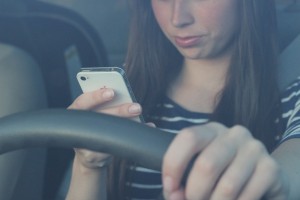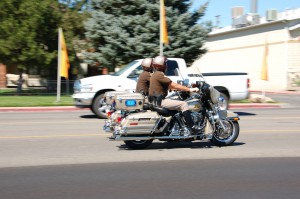SALT LAKE CITY — Kenneth Kenworthy, 25, talked slowly and deliberately, recounting a life-changing accident from his high school days. Now a graduating senior about to earn his business degree in organizational behavior and human resources, Kenworthy remembers traveling outside his school district every day to attend marching band practice at American Fork High School.
Two of his fellow band mates, however, were involved in a tragic car accident and killed, devastating their community. And one of the hardest parts about it? The driver was texting.

“I remember thinking then that it wasn’t very smart,” Kenworthy said. “And as I’ve heard more and more over the years, it seems like everyone knows someone who’s been in an accident related to texting while driving, but people still do it anyway.”
Current law prohibits drivers in Utah from texting while driving, but the word “texting” in the legislation has made the law virtually unenforceable as texting is a small subset of what people do on their phones.
Effective May 13, a new driving law will tighten restrictions on distracting phone behaviors. Drivers will still be able to put your device to your ear, but beyond that, they shouldn’t plan on touching that phone — unless they’re eager to pay a $100 citation.
The new distracted-driver amendments will have police officers looking for any manipulation of a handheld device. That means texting, emailing, dialing a phone number, taking or viewing pictures and videos, surfing the Web and really just about anything else that requires fingers.
Sen. Steve Urquhart, R-St.George, decided to sponsor the bill when one of his constituents, Leslee Henson, inspired him to take a stand on stricter distracted-driving regulations.
On March 4, 2013, Henson was on a routine morning walk with her husband, David. A driver, texting while at the wheel, looked up just in time to see she was hurtling into the slow-moving car ahead. The two cars collided. David Henson threw his wife out of the way, and the second car hit the Hensons, severely injuring Leslee and killing David.
“I realize we have to do something when people are driving,” Sen. Urquhart said. “The act of looking down and being engaged and typing something out is so distracting. I’ve been dangerous doing it. We’ve all been dangerous doing it.”
For most, there’s no question that texting while driving is dangerous. However, the issue is that the current law is ambiguous. It makes it tough for law enforcement to spot texters, especially when all they have to say to get out of a citation is that they were doing anything other than texting.
“The way it’s written right now, even if we do see [texting], we’re not sure if we’re really seeing it,” said Utah Highway Patrol Officer Brent Shelby. “The way they’re changing it is to make it broader and to make it easier to enforce.”

Under the new law, texting while driving will result in a class C misdemeanor, resulting in a $100 fine. But if a driver’s texting and driving results in the injury of another person, the driver will be charged with a more serious class B misdemeanor.
Sen. Urquhart emphasized that the point of tighter restrictions isn’t to bout the number of texting citations.
“It’s not to nail people or to fine them; it’s to encourage different behavior,” he argued. “That’s the intent of the family pursuing this. They don’t want people to get points on their insurance; they want people to commit to it and commit to not do it.”
One of the textingist demographics are teens and young adults. That includes college students, and BYU is no exception.
Textinganddrivingsafety.com, a site dedicated to gathering compelling statistics to support healthy driving behavior, indicates that 77 percent of young adults feel they are “somewhat or very confident” that they can text while driving, and 55 percent feel it’s easy.
But those young drivers are spending a lot of time with their eyes inside their vehicles and their vehicles outside their lanes. The average amount of time a driver takes their eyes of the road when texting is five seconds. Just to put that into perspective, five seconds will take drivers all the way across LaVell Edwards Stadium if they’re moving at freeway speeds.
Brian Woodbury, 25, a senior studying public health, had a health behaviors class that got him thinking more seriously about texting and driving.
“I think on any day you can go out and find BYU students out in their cars, and they’re texting and driving, and they’re trying to do more than one thing at once,” Woodbury said. “Our phones are so second nature, almost. We’re attached to them — we’re glued to them.”
Woodbury doesn’t text while driving, but he does admit to pulling his phone out at the occasional stoplight or stop sign.
“I’ll be sitting at a stoplight, and I’ll be finishing a message and the light changes,” he recalled. “The light turns green, and people are like, ‘What is this guy doing?’” With a little honk of the horn, he’s jolted back to reality.
Many students may be in that same category, composing seemingly harmless texts in the car every now and then. As with Woodbury, sometimes it takes a jolt to get drivers back into reality; but the jolt can be severe.
According to ut.zerofatalities.com, the state-run website promoting safety on Utah roads, there were 11 distraction-related deaths in 2013 in Utah. According to the United States Department of Transportation, drivers who text are 23 times more likely to get in an accident. Almost 1.5 million cell phone-related crashes that occurred last year.
“In all seriousness, it’s not worth the risk that you put on other drivers around you, the vehicles, the potential property damage,” Woodbury said. “It’s not worth the lives.”
This new legislation could mean big changes for some drivers who are accustomed to using their phones. State safety officials are hoping it will mean big changes to the crash statistics.
“There is no reason to text and drive, and there are so many reasons not to,” Kenworthy said, in the wake of his college graduation, a ceremony some young adults never see due to tragic accidents of distraction.
“Most legislation is put in place for the protection of the citizenry, and I think that this (new law) applies there,” he continued. “And I think that kind of legislation is pretty valid.”
For more information on the bill, visit le.utah.gov.




